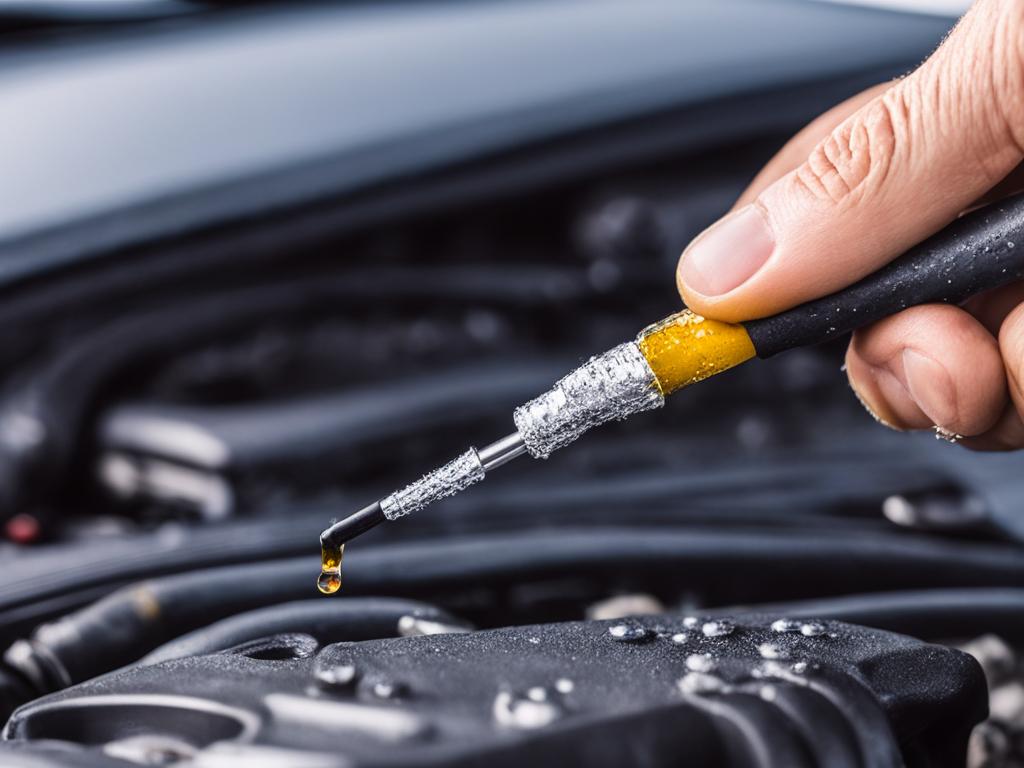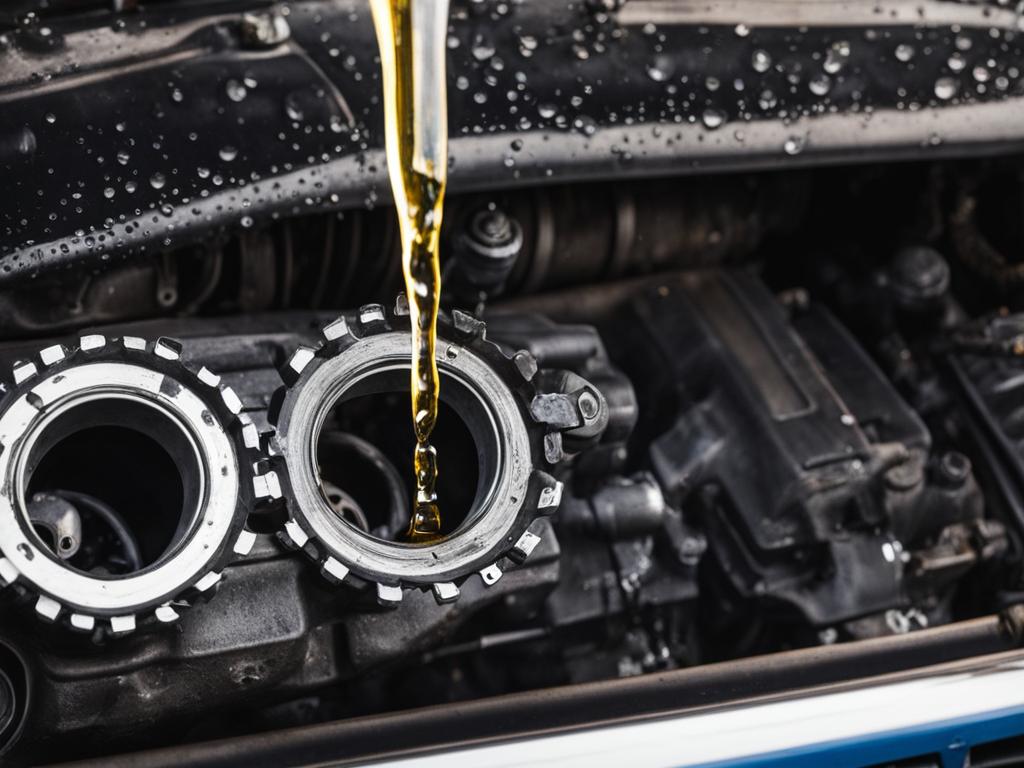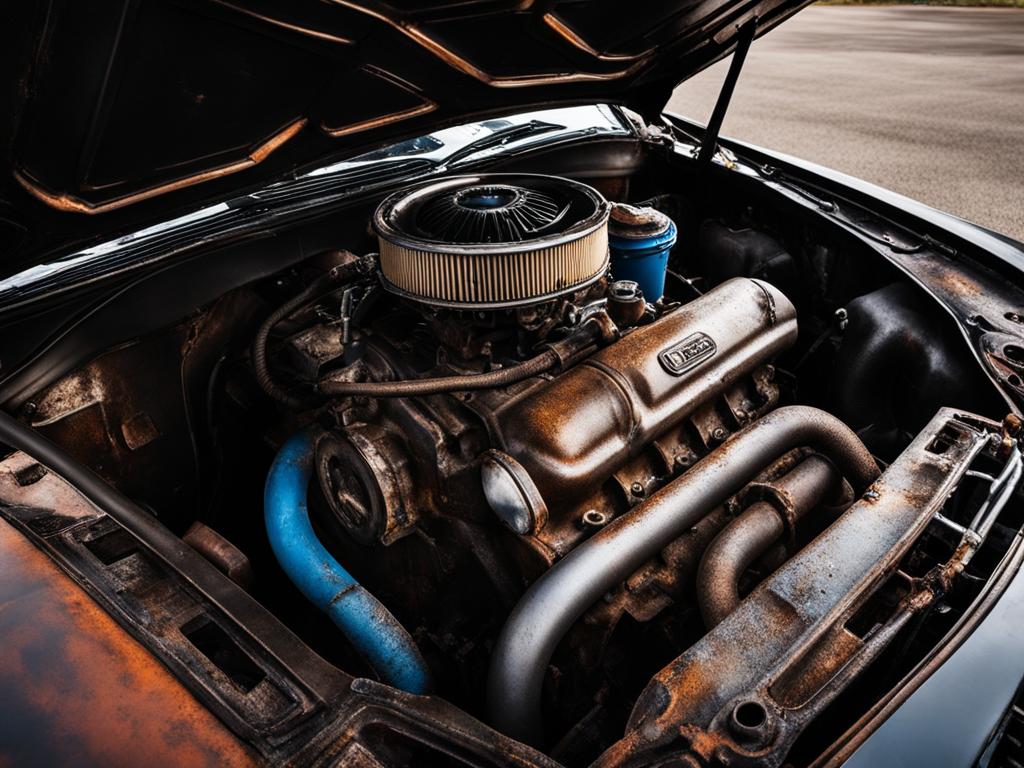New Car First Oil Change: Best Practices & Timing
If you’ve recently purchased a new car, one important aspect of maintenance to consider is the first oil change. Changing the oil in a new vehicle is crucial for ensuring its longevity and optimal performance. In this article, we will explore the best practices and timing for the first oil change in a new car.
Key Takeaways:
- Follow the manufacturer’s recommendations for the first oil change in your new car.
- Advancements in engine technology have extended oil change intervals to 7,500 to 10,000 miles or more.
- Consult with a professional car mechanic for guidance if unsure about the recommended interval.
- Regular oil changes are essential for maintaining the health and longevity of the engine.
- Consider factors such as severe driving conditions and towing, which may require more frequent oil changes.
When Should You Change the Engine Oil for The First Time?
The engine oil in your new car plays a critical role in maintaining its performance and longevity. The vehicle owner’s manual provides the recommended interval for changing the engine oil, ensuring that the engine operates at its best. In the past, it was common to change the oil every 3,000 miles, but advancements in engine technology have extended the oil change interval to 7,500 to 10,000 miles.
While it may be tempting to follow the traditional 3,000-mile rule, it is best to adhere to the manufacturer’s recommendations for the first oil change on a new car. The manufacturer has carefully designed the engine and determined the ideal interval for oil changes based on various factors, such as engine materials and oil chemistry.
If you are unsure about when to change the engine oil for the first time, consult with a car mechanic. They can provide expert guidance based on their knowledge and experience.
“The manufacturer’s recommendations for the first oil change on a new car are designed to ensure optimal engine performance and longevity.”
Following the manufacturer’s recommendations for the first oil change helps establish a solid foundation for the car’s engine maintenance. It sets the stage for future oil changes and helps you track the proper intervals for subsequent maintenance tasks.
By adhering to the recommended oil change interval, you ensure that the engine is properly lubricated, preventing excessive wear and tear. This can result in improved fuel efficiency, reduced emissions, and a smoother driving experience.
Remember, the first oil change is just the beginning of a regular maintenance routine that will keep your new car running smoothly for years to come.
| Traditional Interval | Manufacturer’s Interval | Importance |
|---|---|---|
| Every 3,000 miles | 7,500 to 10,000 miles | Adhere to manufacturer’s recommendations for optimal engine performance and longevity. |
Is it necessary to do the first oil change as soon as possible?
When it comes to the first oil change in a fresh new vehicle, there is often a sense of urgency to get it done as soon as possible. However, it is important to understand the facts and follow the manufacturer’s guidelines to avoid potential engine damage.
Contrary to popular belief, changing the oil right away is not necessary. The oil that comes with a new car is specifically designed to meet the engine’s requirements during the initial break-in period. It is still suitable for the engine and will provide adequate lubrication until the recommended interval for the first oil change is reached.
Exceeding the recommended interval for the first oil change can have severe consequences. Fresh oil contains additives that help protect the engine from damage and minimize wear and tear. By delaying or neglecting the first oil change, these additives may degrade, leaving the engine vulnerable to premature wear, increased friction, and potential engine damage.
Therefore, it is crucial to follow the manufacturer’s guidelines for the first oil change in a new car. This ensures that the engine receives the necessary lubrication and protection, leading to optimal performance, longevity, and peace of mind for the vehicle owner.
When should you service a new vehicle for the first time?
Proper maintenance is essential to ensure the longevity and optimal performance of a new vehicle. The first service plays a crucial role in setting the foundation for the vehicle’s future maintenance schedule. Most manufacturers recommend servicing a new vehicle every 12,000 miles or 12 months, whichever comes first. By following these recommended service intervals, you can maintain the vehicle’s warranty and keep it in top condition.
However, it’s important to note that different manufacturers may have varying guidelines for the first service. To determine the exact recommended service intervals for your specific vehicle, consult the manufacturer’s handbook or contact your local dealership. They will provide you with the most accurate and up-to-date information based on the make and model of your vehicle.
The first service is an opportune time for the manufacturer or dealership to inspect and address any potential issues and ensure that your vehicle is running smoothly. They will typically perform a comprehensive check of various components, such as the engine, transmission, brakes, and fluids. This allows them to detect any early signs of possible problems and prevent them from escalating into larger, more expensive issues.
During the first service, the professional technicians may also provide recommendations based on your specific driving habits and conditions. These valuable insights can help you establish a personalized maintenance plan that takes into account factors such as frequent short trips, extreme temperatures, or heavy towing, which may require more frequent servicing.
By adhering to the manufacturer’s recommended service intervals and staying proactive with maintenance, you can keep your new vehicle in optimal condition, ensuring its longevity and reliability for years to come.

First Service Checklist
| Services | Description |
|---|---|
| Engine Inspection | Thorough check of the engine’s components and performance. |
| Fluid Checks | Ensure all fluids, including engine oil, coolant, and brake fluid, are at the appropriate levels. |
| Brake Inspection | Inspect brake pads, rotors, and calipers for wear and ensure proper functionality. |
| Tire Rotation | Rotate tires to promote even wear and increase their lifespan. |
| Filter Replacement | Replace oil filter, air filter, and cabin filter, if necessary, to optimize performance and air quality. |
| Electrical System Check | Inspect battery health, test lights and electronics, and ensure proper charging system functionality. |
| Visual Inspection | Thoroughly examine the vehicle for any visible signs of damage or wear. |
How often should you change the oil in a new car?
The frequency of oil changes in a new car depends on the manufacturer’s recommendations. Modern engines driven under normal conditions can stretch oil change intervals to 7,500 to 10,000 miles or more. However, it is important to consider factors such as severe driving conditions, short trips, extreme temperatures, and towing, as these may require more frequent oil changes. The owner’s manual or oil-life monitor system in the vehicle can provide specific guidance.
Regular oil changes are essential for maintaining the engine’s health and performance. While new cars allow for longer oil change intervals, it is still crucial to follow the manufacturer’s recommendations to ensure optimal engine protection and efficiency. Neglecting regular oil changes can lead to increased wear and tear, reduced fuel economy, and potentially severe engine damage over time.
Factors to Consider for Oil Change Intervals:
- Severe driving conditions such as frequent stop-and-go driving, towing, or driving in dusty environments may require more frequent oil changes. Refer to the owner’s manual for specific recommendations based on your driving habits.
- Short trips and cold starts can result in moisture accumulation in the engine oil, leading to increased engine wear. More frequent oil changes may be necessary in such cases.
- Extreme temperatures can place additional stress on the engine and the oil. High heat can cause oil to degrade faster, while cold temperatures can affect the oil’s ability to flow smoothly. Consider more frequent oil changes if you frequently experience extreme temperature conditions.
To determine the precise oil change interval for your new car, consult the owner’s manual or utilize the oil-life monitor system, if equipped. These resources take into account the specific engine design, oil type, and driving conditions to provide accurate recommendations for oil change intervals. Following these guidelines will help ensure the longevity and efficient performance of your new car’s engine.
| Driving Conditions | Recommended Oil Change Interval |
|---|---|
| Normal Driving Conditions | 7,500 to 10,000 miles or as recommended by the manufacturer |
| Severe Driving Conditions | Every 3,000 to 5,000 miles or as recommended by the manufacturer |
How to Check Your Oil Level and Condition?
To ensure proper engine maintenance, it’s essential to regularly check your car’s oil level and condition. By monitoring these factors, you can identify potential issues early on and prevent damage to your engine. Here’s a step-by-step guide on how to check your oil level and condition:
- Park the car on level ground and let the engine cool down.
- Open the hood and locate the dipstick.
- Slowly pull out the dipstick and wipe off any oil using a clean cloth or paper towel.
- Reinsert the dipstick fully into its tube.
- Remove the dipstick again and hold it horizontally to check the oil level.
- Observe the indicators on the dipstick to determine if the oil level is within the recommended range.
- Pay attention to the color and consistency of the oil. It should appear brown or black, indicating normal oil condition. If the oil is milky or contaminated, it may indicate a more serious problem and should be inspected by a mechanic.
- If the oil level is below the minimum mark or if there are any concerns about the oil condition, consult a mechanic for further diagnosis.
Why is it important to check your oil level and condition?
Regularly checking your car’s oil level and condition is vital for engine maintenance. It ensures that there is sufficient oil to lubricate the engine’s moving parts and helps dissipate heat. Additionally, monitoring the oil condition can help detect potential issues, such as coolant contamination or the presence of harmful particles, which may indicate engine problems.
By following these simple steps and staying vigilant about your car’s oil level and condition, you can contribute to the longevity and optimal performance of your vehicle’s engine.

Should you use synthetic oil for your new car?
The choice between synthetic oil and conventional oil depends on the manufacturer’s recommendations for your specific new car. Many newer vehicles use synthetic oil, which offers better engine protection and extended oil change intervals. Synthetic oil is formulated with high-quality base oils and advanced additives that provide superior lubrication, reduce friction, and offer improved resistance to heat and oxidation.
If your car requires synthetic oil, it is important to use it as specified by the manufacturer. Synthetic oil provides excellent engine protection, especially in extreme temperatures and demanding driving conditions. It maintains its viscosity and lubricating properties for a longer period, enhancing the overall performance and longevity of your engine.
On the other hand, if your car uses conventional oil, you have the option to choose between synthetic or conventional oil based on your specific needs and driving conditions. Synthetic oil can still be used in engines that typically use conventional oil, offering enhanced protection and improved performance. However, it’s essential to note that using synthetic oil may not be necessary or cost-effective for all cars.
Ultimately, the decision to use synthetic or conventional oil depends on factors such as the manufacturer’s guidelines, your driving habits, and the specific requirements of your vehicle. Consulting your owner’s manual or speaking with a qualified mechanic can help you determine the best oil type for your new car.
Choosing the right oil for your new car is essential for engine protection and optimal performance. Whether you opt for synthetic or conventional oil, regular oil changes and proper maintenance are crucial to ensure the longevity and efficiency of your engine.
Are frequent oil changes better for your new car?
When it comes to oil changes for your new car, the question of frequency often arises. While frequent oil changes can never hurt your engine, they are not necessary for most driving situations. The key is to follow the manufacturer’s recommended oil change intervals, which are designed to keep your engine running smoothly and efficiently.
Most modern vehicles now have longer oil change intervals compared to older models. These intervals typically range from 7,500 to 10,000 miles or more. The recommended interval usually includes an oil filter change as well. Following these guidelines ensures that your engine gets the fresh, clean oil it needs for optimal performance and longevity.
However, there are exceptions to the standard intervals. If you frequently drive in severe conditions, such as extreme temperatures, dusty roads, or if you tow heavy loads, more frequent oil changes may be beneficial. Severe driving conditions can place extra stress on your engine, and changing the oil more often can help ensure its continued well-being.
To determine the specific oil change intervals for your new car, consult the owner’s manual or utilize the vehicle’s oil-life monitor system. These resources provide valuable guidance based on the manufacturer’s recommendations and are tailored to your specific make and model.
Remember, maintaining your engine’s health is essential for the overall performance and longevity of your new car.
The Benefits of Frequent Oil Changes
While frequent oil changes may not be necessary for most driving situations, there are certain benefits to consider:
- Improved engine protection: Fresh oil provides better lubrication, reducing friction and wear on engine components.
- Efficient contaminant removal: Regular oil changes help remove dirt, debris, and contaminants that can accumulate in the oil over time, improving engine cleanliness.
- Extended engine life: By following recommended oil change intervals, you can minimize engine wear and prolong your car’s overall lifespan.
By understanding your vehicle’s specific needs and adhering to the manufacturer’s guidelines, you can ensure that your new car receives the necessary engine maintenance to perform at its best.

Comparison of Oil Change Intervals
| Driving Conditions | Recommended Oil Change Intervals |
|---|---|
| Normal driving conditions | 7,500 to 10,000 miles or as specified by the manufacturer |
| Severe driving conditions: extreme temperatures, dusty roads | Every 3,000 to 5,000 miles or every 3 to 6 months |
| Severe driving conditions: towing heavy loads | Every 3,000 to 5,000 miles or every 3 to 6 months |
Note: The intervals provided are general guidelines. Always refer to your vehicle’s owner’s manual for the manufacturer’s specific recommendations.
Do you need special motor oil for an older car?
If your older car is running well, it does not necessarily need special motor oil. Check the owner’s manual or consult with a local dealer or online enthusiast group for the recommended oil for your particular model. The automaker chose the recommended oil for a reason, so it is best to stick with their guidance. However, if your car experiences specific issues or conditions, such as short trips, extreme temperatures, or heavy towing, using premium extended-life synthetic oils may provide added protection and prolong your engine’s life.
Recommended Oil for Older Cars
When it comes to the recommended oil for older cars, it is essential to refer to the manufacturer’s guidelines. The owner’s manual should provide detailed information about the recommended oil grade, viscosity, and any specific requirements for your particular model. Following the manufacturer’s recommendations ensures that you are using the oil that is optimal for your engine’s performance and longevity.
It’s worth noting that the automaker chose the recommended oil based on extensive testing and engineering specifications. Therefore, it is generally advisable to stick with their guidance rather than deviating to a different type, as they have taken into account the specific characteristics of your vehicle’s engine.
Considerations for Special Motor Oil
While most older cars can use conventional motor oil without any issues, there are certain situations where using special motor oil may be beneficial. If your car experiences specific issues or conditions that put extra stress on the engine, such as frequent short trips, extreme temperatures, or heavy towing, using premium extended-life synthetic oils can provide added protection.
Using premium extended-life synthetic oils can help combat the effects of frequent short trips, where the engine may not have sufficient time to warm up and reach optimal operating conditions. These oils have additives that offer better protection during cold starts, reducing wear and tear on the engine components.
In areas with extreme temperatures, whether extremely cold or hot, special motor oils offer better viscosity stability. This means that the oil maintains its optimal thickness and lubrication properties, even in harsh temperature conditions, ensuring that the engine is protected and can operate smoothly.
For older cars used for heavy towing, special motor oils with higher levels of detergents and additives can help remove and prevent the buildup of deposits and contaminants, enhancing engine performance and overall longevity.
Conventional Motor Oil vs. Synthetic Motor Oil
| Conventional Motor Oil | Synthetic Motor Oil |
|---|---|
| Good performance in standard operating conditions | Improved performance in extreme conditions |
| Requires more frequent oil changes | Extended oil change intervals |
| Lower initial cost | Higher initial cost |
While conventional motor oil is suitable for most older cars, synthetic motor oil offers several advantages, particularly in extreme operating conditions. Synthetic motor oils provide better protection in high-stress situations and allow for extended oil change intervals, reducing maintenance frequency and costs over time.
Ultimately, the choice between conventional and synthetic motor oil for your older car depends on the manufacturer’s recommendations and your specific driving conditions. Consulting with a trusted mechanic or experienced car enthusiasts can provide valuable insights and help you make an informed decision.

How often should you change synthetic oil?
The frequency of synthetic oil changes depends on the specific type of synthetic oil used and the manufacturer’s recommendations. Extended-life synthetic oils are designed to last longer between changes, providing optimal engine protection and performance. These oils contain special additives that help resist high-temperature breakdown and keep dirt and particulates in suspension for extended periods.
Some synthetic oils can last up to 10,000 or even 12,000 miles between changes. However, it is crucial to follow the manufacturer’s recommended time interval to ensure the oil maintains its effectiveness and protects the engine efficiently.
The recommended time interval for synthetic oil changes is typically around six months to a year, even if the vehicle is driven fewer miles or on shorter trips. This regularity ensures that the oil remains fresh and maintains its protective properties.
It is important to note that driving conditions and habits can also impact the oil change frequency. For example, severe driving conditions such as extreme temperatures, excessive idling, towing, or frequent stop-and-go traffic may require more frequent oil changes. Be sure to consult your vehicle’s owner’s manual or the oil manufacturer’s recommendations for specific guidance based on your driving habits.
Extended-life synthetic oil change intervals:
| Oil Type | Recommended Interval |
|---|---|
| Extended-life synthetic oil | Up to 10,000 or 12,000 miles |
Remember, regular oil changes are essential for maintaining your engine’s longevity and protection, regardless of the type of oil used. Adhering to the recommended oil change intervals ensures that your engine stays properly lubricated and reduces the risk of damage or premature wear.

What happens if you go too long without an oil change?
Skipping regular oil changes can have severe consequences for your engine and overall vehicle maintenance. As time goes on, the quality of the oil deteriorates, reducing its effectiveness in lubricating and cooling the engine components. This can lead to increased friction, heat buildup, and accelerated wear and tear on vital engine parts.
Increased Friction: Without fresh oil to reduce friction, the moving parts of your engine rub against each other, causing increased wear and tear. This can result in engine damage and reduced performance.
Heat Buildup: Inadequate lubrication due to old oil can cause the engine to overheat. Excess heat can warp engine components, leading to costly repairs and decreased engine efficiency.
Accelerated Wear and Tear: Over time, the lack of proper lubrication and cooling can cause parts to wear out more quickly. This can result in premature engine failure and the need for costly repairs or even a new engine.
Regular oil changes are essential for maintaining the health and longevity of your engine. Neglecting this crucial maintenance task can result in severe engine damage. To avoid these consequences, it is vital to follow the manufacturer’s recommended oil change intervals and keep up with regular vehicle maintenance.

| Consequences | Description |
|---|---|
| Increased Friction | Without fresh oil, engine parts rub against each other, resulting in increased wear and reduced performance. |
| Heat Buildup | Old oil cannot effectively absorb and dissipate heat, leading to engine overheating and potential damage. |
| Accelerated Wear and Tear | The lack of proper lubrication and cooling causes parts to wear out faster, potentially leading to engine failure. |
How to check your car’s oil level?
Maintaining the proper oil level in your car is crucial for engine performance and longevity. Regularly checking the oil level ensures that your engine is properly lubricated and protected. Follow these simple steps to check your car’s oil level:
- Park the car on level ground and turn off the engine.
- Locate the oil dipstick, which is usually labeled with a bright-colored handle.
- Pull the dipstick out and wipe it clean with a cloth or paper towel.
- Insert the dipstick back into the tube fully, then pull it out again.
- Observe the oil level on the dipstick.
The dipstick will have markings indicating the ideal oil level range. If the oil level is below the minimum mark, it is time to add oil. Conversely, if the oil level is above the maximum mark, you may have overfilled the oil and should remove the excess.
Make sure to check the oil level regularly, especially before long trips or when you suspect there may be an issue with your oil consumption. By maintaining the proper oil level, you can ensure optimal engine performance and avoid potential damage caused by insufficient lubrication.

| Oil Level Markings | Interpretation |
|---|---|
| Below the minimum mark | The oil level is too low. Add oil to bring it to the recommended range. |
| Between the minimum and maximum marks | The oil level is within the acceptable range. No immediate action is needed. |
| Above the maximum mark | The oil level is too high. Drain or siphon out the excess oil to prevent damage. |
How to change your car’s oil?
Changing your car’s oil is an essential part of engine maintenance that can be done in a few simple steps:
- Gather the necessary tools and equipment, including an oil filter, wrench, drain pan, new oil, and funnel.
- Jack up the car and secure it with jack stands to create a safe working environment.
- Locate the oil drain plug underneath the car and loosen it with a wrench.
- Position the drain pan beneath the plug to catch the old oil as it drains out completely.
- Remove the old oil filter and replace it with a new one. Before installing the new filter, apply a thin layer of oil to the new filter gasket for a proper seal.
- Tighten the drain plug securely and install the new oil filter using the manufacturer’s specifications.
- Use a funnel to pour the recommended amount of new oil into the engine. Refer to your vehicle’s owner manual for the correct oil type and quantity.
- Start the engine and let it run for a few minutes to circulate the new oil throughout the system.
- Turn off the engine and wait a few minutes for the oil to settle. Check the oil level using the dipstick and add more oil if necessary.
- Once you have finished changing the oil, it is important to properly dispose of the old oil and clean up any spills or drips to protect the environment.
Note: Consult your vehicle’s owner manual for specific instructions and recommendations related to your car’s oil change process.
By performing a DIY oil change, you can save money and ensure that your engine is properly maintained for optimal performance.
Maintaining Your Engine’s Health
Regular oil changes are an integral part of engine maintenance. By changing your car’s oil at the recommended intervals, you can:
- Extend the lifespan of your engine.
- Improve fuel efficiency.
- Prevent potential engine damage.
- Enhance overall performance.
With proper care and maintenance, your engine will continue to perform at its best for years to come.
| Pros of DIY Oil Change | Cons of DIY Oil Change |
|---|---|
|
|

How to Recycle Used Oil?
Proper disposal of used oil is essential to protect the environment and promote sustainable practices. It is crucial to never dispose of used oil in the trash or pour it down the drain. Recycling used oil helps reduce pollution and conserves natural resources. Here’s how you can responsibly recycle your used oil:
- Store the oil: After performing an oil change, collect the used oil in a sealable container to prevent spills and contamination.
- Find a collection center: Most auto-parts stores and oil-change businesses accept used oil for recycling. Locate one of these authorized centers in your area.
- Transport the oil: Safely transport the used oil to the collection center, ensuring it remains in a sealed container to prevent leaks.
- Hand over the oil: At the collection center, hand over the used oil to the staff. They will handle the recycling process in an environmentally responsible manner.
By recycling used oil, you are actively contributing to environmental sustainability and preventing potential harm to our ecosystems. Remember, every small effort counts towards a cleaner and greener future.
| Benefits of Recycling Used Oil | Environmental Impact |
|---|---|
| Conserves natural resources | Reduces pollution and soil contamination |
| Prevents water pollution | Protects aquatic life from oil spills |
| Reduces energy consumption | Decreases the need for new oil production |
| Promotes sustainability | Helps create a greener future for generations to come |
The importance of regular oil changes
Regular oil changes are crucial for maintaining the overall health and longevity of a vehicle’s engine. Oil plays a vital role in lubricating the engine’s moving parts, reducing friction, and preventing heat buildup that can lead to excessive wear and tear. Additionally, oil helps to remove contaminants and debris that can accumulate over time and cause damage to sensitive engine components.
By following the manufacturer’s recommended oil change intervals, you ensure that your engine is properly protected and operating at its best. These intervals are designed based on extensive research and engineering to provide optimal performance and reliability for your specific vehicle model.
Failure to adhere to regular oil changes can have detrimental effects on your engine. Over time, oil can break down and lose its effectiveness, becoming less efficient at lubricating and cooling the engine. This can lead to increased friction, heat buildup, and accelerated wear on vital engine parts, such as the pistons, cylinders, and bearings.
Neglecting regular oil changes can result in:
- Reduced engine performance.
- Increased fuel consumption.
- Potential engine failure.
To ensure the longevity and optimal performance of your engine, it is essential to prioritize regular oil changes according to the manufacturer’s recommended intervals. By doing so, you take proactive steps towards maintaining the health and efficiency of your vehicle’s engine for years to come.

| Benefits of Regular Oil Changes | Consequences of Neglecting Oil Changes |
|---|---|
|
|
Conclusion
The first oil change for a new car is a crucial maintenance task that should be performed in accordance with the manufacturer’s recommendations. With advancements in engine technology, oil change intervals have extended, but it’s important to consider factors such as severe driving conditions and towing, which may necessitate more frequent oil changes. Regular oil changes, along with proper maintenance, are key to ensuring the longevity and optimal performance of your vehicle’s engine.
By following best practices and adhering to the manufacturer’s guidelines, you can avoid potential engine damage and maintain your car’s warranty. While it may be tempting to delay or skip the first oil change, it is essential to change the oil within the recommended interval for a fresh new vehicle experience.
To keep your new car running smoothly, consult your owner’s manual for the recommended oil change interval, especially for the first oil change. If you have any doubts or questions, professional car mechanics are always available to provide guidance and advice.
FAQ
When should you change the engine oil for the first time?
The vehicle owner’s manual provides the recommended interval for changing the engine oil. In the past, an oil change was suggested every 3,000 miles. However, advancements in engine technology have extended the oil change interval to 7,500 to 10,000 miles. It is best to follow the manufacturer’s recommendations for the first oil change on a new car. If in doubt, consult with a car mechanic for guidance.
Is it necessary to do the first oil change as soon as possible?
While it is important not to let a car’s engine oil remain in the vehicle longer than the manufacturer recommends, changing the oil before the recommended interval on a new car is unnecessary. The oil will still be appropriate for the engine until the recommended interval is reached. However, exceeding the recommended interval can result in significant engine damage. It is crucial to follow the manufacturer’s guidelines for oil changes.
When should you service a new vehicle for the first time?
Most manufacturers recommend servicing a new vehicle every 12,000 miles or 12 months, whichever comes first. This is the optimal time to perform the first service and ensure the vehicle’s longevity. However, it is important to consult the manufacturer’s handbook for the exact recommended service intervals for your specific vehicle, as some manufacturers may have different guidelines.
How often should you change the oil in a new car?
The frequency of oil changes in a new car depends on the manufacturer’s recommendations. Modern engines driven under normal conditions can stretch oil change intervals to 7,500 to 10,000 miles or more. However, it is important to consider factors such as severe driving conditions, short trips, extreme temperatures, and towing, as these may require more frequent oil changes. The owner’s manual or oil-life monitor system in the vehicle can provide specific guidance.
How to check your oil level and condition?
To check the oil level, park the car on level ground and let the engine cool down. Open the hood and locate the dipstick, then pull it out and wipe off any oil. Reinsert the dipstick fully, then pull it out again and check the oil level against the indicators on the dipstick. Additionally, pay attention to the color and consistency of the oil. It should appear brown or black, not milky or contaminated. If there are any concerns about the oil level or quality, consult a mechanic for further diagnosis.
Should you use synthetic oil for your new car?
The choice between synthetic oil and conventional oil depends on the manufacturer’s recommendations for your specific new car. Many newer vehicles use synthetic oil, which offers better engine protection and extended oil change intervals. If your car requires synthetic oil, it is important to use it as specified by the manufacturer. However, if your car uses conventional oil, you have the option to choose between synthetic or conventional oil based on your specific needs and driving conditions.
Are frequent oil changes better for your new car?
While frequent oil changes can never hurt your engine, it is not necessary unless you drive in severe conditions. The manufacturer’s recommended oil change intervals, which often include an oil filter change, should be followed for most driving situations. However, if you frequently drive in severe conditions such as extreme temperatures, dusty roads, or tow heavy loads, more frequent oil changes may be beneficial. Consult the owner’s manual or oil-life monitor for specific guidance.
Do you need special motor oil for an older car?
If your older car is running well, it does not necessarily need special motor oil. Check the owner’s manual or consult with a local dealer or online enthusiast group for the recommended oil for your particular model. The automaker chose the recommended oil for a reason, so it is best to stick with their guidance. However, if your car experiences specific issues or conditions, such as short trips, extreme temperatures, or heavy towing, using premium extended-life synthetic oils may provide added protection and prolong your engine’s life.
How often should you change synthetic oil?
The change frequency for synthetic oil depends on the specific synthetic oil used and the manufacturer’s recommendations. Some synthetic oils are designed to last up to 10,000 or even 12,000 miles between changes. These oils have special additives that help them resist high-temperature breakdown and keep dirt and particulates in suspension longer. However, it is still important to follow the manufacturer’s recommended time interval, typically six months to a year, if the vehicle is not driven many miles or on many short trips.
What happens if you go too long without an oil change?
Going excessively long without an oil change can result in severe engine damage. As the oil quality deteriorates, it becomes less effective at lubricating and cooling the engine components. This can lead to increased friction, heat buildup, and accelerated wear and tear. Eventually, the engine may fail completely, resulting in costly repairs or the need for a new engine. Regular oil changes are essential for maintaining the overall health and longevity of the engine.
How to check your car’s oil level?
Checking the oil level in your car is a simple process. Park the car on level ground and turn off the engine. Locate the oil dipstick, usually labeled with a bright-colored handle. Pull the dipstick out and wipe it clean with a cloth or paper towel. Insert the dipstick back into the tube fully, then pull it out again and observe the oil level. The dipstick will have markings indicating the ideal oil level range. If the oil level is below the minimum mark, it is time to add oil.
How to change your car’s oil?
Changing your car’s oil can be done by following these steps: Gather the necessary tools and equipment, including an oil filter, wrench, drain pan, new oil, and funnel. Jack up the car and secure it with jack stands. Locate the oil drain plug and loosen it with a wrench. Position the drain pan beneath the plug and allow the old oil to drain completely. Remove the old oil filter and replace it with a new one. Apply a thin layer of oil to the new filter gasket. Tighten the drain plug and install the new filter. Use a funnel to pour the recommended amount of new oil into the engine. Start the engine and let it run for a few minutes to circulate the new oil. Turn off the engine and check the oil level. Add more oil if necessary. Properly dispose of the old oil and clean up any spills or drips.
How to recycle used oil?
Used oil should never be disposed of in the trash or poured down the drain. It is important to properly recycle used oil to protect the environment. Most auto-parts stores and oil-change businesses accept used oil for recycling. Simply bring your used oil to one of these locations, preferably in a sealed container, and they will handle the recycling process. Recycling used oil helps reduce pollution and conserves natural resources.
The importance of regular oil changes
Regular oil changes are crucial for maintaining the overall health and longevity of a vehicle’s engine. Oil lubricates the engine’s moving parts, reducing friction and heat buildup. It also helps remove contaminants and debris that can accumulate over time. By following the manufacturer’s recommended oil change intervals, you ensure that the engine is properly protected and operating at its best. Neglecting oil changes can result in reduced engine performance, increased fuel consumption, and even engine failure.
Conclusion
The first oil change for a new car is an important maintenance task that should be performed according to the manufacturer’s recommendations. While advancements in engine technology have extended oil change intervals, it is important to consider factors such as severe driving conditions and towing, which may require more frequent oil changes. Regular oil changes, along with proper maintenance, contribute to the longevity and optimal performance of the vehicle’s engine.




